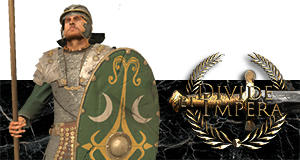One thing I love doing in this game is trying to use “realistic” or “historically accurate” army compositions. I have to balance that, however, against the need to actually win battles. So I am willing to compromise to a certain extent. What are some of your preferred army compositions? What do you find effective?
I’ll start by discussing my current Roman campaign, because I am rather dissatisfied with my Marian legions.
Starting Roman legion:
1 General
1 Supply Wagon
4 Hastati / Allied Hastati
4 Principes / Allied Principes
2 Triarii / Allied Heavy Spears
4 Equites / Allied Cavalry
4 Velites / javelin troops
I find this composition is generally effective. It’s not great, but it works. I’ll be honest, I win my battles on the campaign map. I’m usually able to bring more troops than the AI. I isolate him whenever possible to maximize winning battles with minimal casualties. I know it probably has too much cavalry for purists, but that's one concession I had to make to get an army that was effective. This composition gets much stronger after the Polybian reforms. As I campaign further afield, I also allow myself to make it even stronger my replacing two of my javelin troops with long range missile troops, such as Cretan archers, Balearic slingers, etc.
I have more difficulty, however, with my Marian armies. I expected them to be more effective. But in my current campaigns against the Lusitani and Kartli, I am having some real troubles. I’m taking much heavier casualties than I expect, despite having experienced troops with gold weapons, armor, and horses.
This is my Marian composition:
1 General
1 Supply wagon
1 First Cohort (3 gold chevrons)
9 Legionaries (3 gold chevrons)
4 Ala Hispanorum (2 bronze chevrons)
2 Scorpions
2 Romanized Balearic Slingers (2 bronze chevrons)
Three or four times now, I have used one of these against a half stack of Lusitani. Each time I have taken 20-30% casualties. The enemy has attacked me very vigorously each time. The hostile cavalry appears superior to my own. I tested with auto resolve and got similar results. Why?
So, my opinion is that the Scorpions are my problem. I have noticed that the AI is much more aggressive against this composition than my earlier army. They charge in very vigorously. While I still win, it’s a knife fight (in a knife fight, one person dies in the street, the other dies in the ambulance). I tested this out by adding a couple of ballista to my early army and had similar results. It makes sense to me: the AI should not just sit there and let my artillery destroy him. With that vigorous enemy attack, the Scorpions don’t have time to get many kills. I think I will have to replace them with two long range archer units (very useful and flexible units).
Other interesting observations from this army composition: the AI hates the First Cohort. It always attracts a lot of missiles. As does the baggage train and the General (and all for the same reason).
Thoughts? Compositions for other factions?





 Reply With Quote
Reply With Quote









